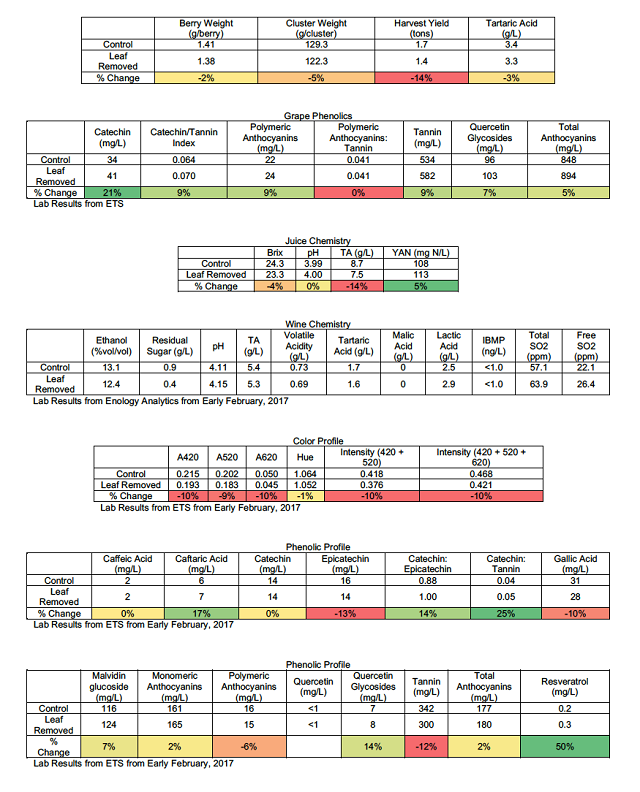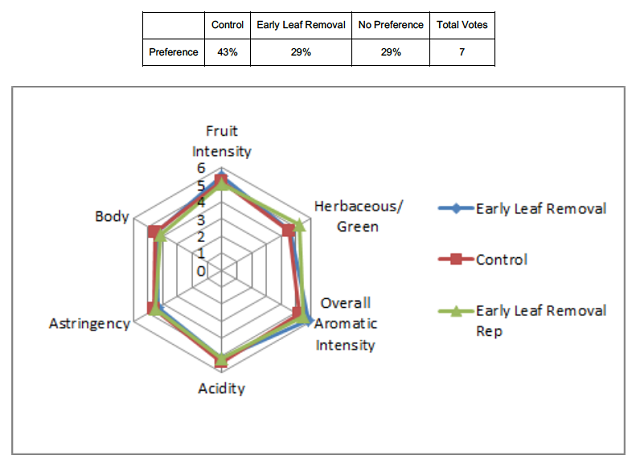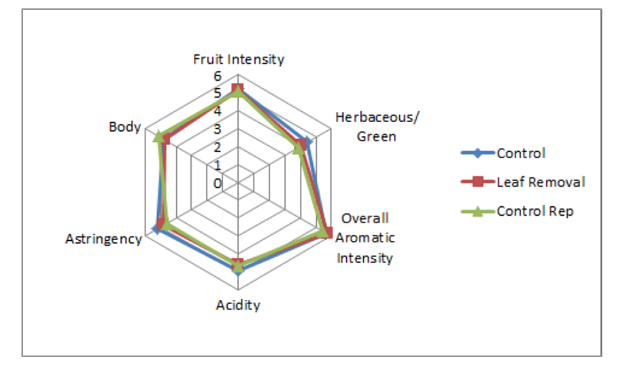The Effect of Leaf Removal at Bloom vs Leaf Removal at Veraison on Ripeness (2018)
Jordan Harris and Kevin Goolsby
Tarara Winery
Summary
This study examines the impact of removing the 4 most basal leaves from Cabernet Sauvignon vines at 30% bloom. One section of a vineyard block was not leafed at bloom, while another section underwent this leafing treatment. Both treatments received leaf-pulling at veraison. All other vineyard and fermentation practices were the same. Leaf removal at bloom appeared to slightly reduce berry weight, cluster weight, Brix, and yield. Grape phenolics and TA were slightly increased by bloom leaf removal. Wine produced with leaf removal at bloom had lower ethanol, color intensity, and tannin. Judges did not find the wines to be significantly different, and there were no strong preference trends for either wine. Early leaf removal may have had a very weak tendency to increase Overall Aromatic Intensity. The lack of differences are likely due in part to the particular vintage (weather events may have equalized the treatments) and in part due to vegetative growth reducing the effectiveness of the bloom leaf removal. More studies need to be performed in this area in order to draw more conclusions.
Introduction
Leaf pulling in the fruiting zone reduces disease pressure, helps fruit to dry, improves chemical composition of the fruit. However, removing too many leaves can result in too high of acid reduction and sunburn. Generally, leaf pulling is often performed at or after fruit set, which increases the fruit’s resistance to sunburn (Wolf 2001). However, leaf removal is often performed after berry set. Recently, great interest has arisen in investigating the impact of pre-bloom leaf removal on fruit yield, micro-climate, and quality.
Because basal leaves at bloom are the primary source of carbohydrates for inflorescences at this stage (Coombe 1962), pre-bloom leaf removal reduces set and thus reduces cluster weight (Poni et al. 2006). Early leaf removal results in less compact clusters, which helps to reduce Botrytis incidence as well as reduces crop yield. It also tends to reduce berry size and enhance many chemical ripeness parameters (Smith and Centinari 2017). The purpose of this study is to investigate the effects of leaf removal at different growing stages and the resulting fruit and wine.
Results and Discussion
The 2016 season was a poor season for Cabernet Sauvignon at this site. A heavy rain came before harvest, and an early frost also damaged fruit quality. Additionally, the fruiting zone was not continuously kept clear of vegetative growth (such as laterals pushing) for the bloom-leaf removal treatment. Thus, this treatment may have not fully exposed grapes for as long as they should have been. Leaf removal at bloom appeared to slightly reduce berry weight, cluster weight, Brix, and yield. Grape phenolics and TA were slightly increased by bloom leaf removal. Wine produced with leaf removal at bloom had lower ethanol, color intensity, and tannin.

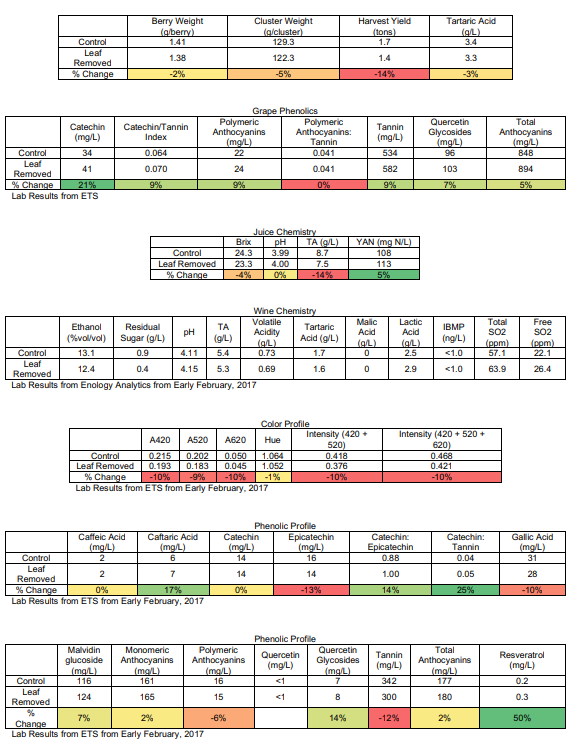
For the triangle test on April 12, of 18 people who answered, 8 people chose the correct wine (44%), suggesting that the wines were not significantly different. In general, people who answered correctly had no major preference trends. Descriptive analysis did not discover any strong trends between treatments. Early leaf removal had a slight tendency to increase Overall Aromatic Intensity.
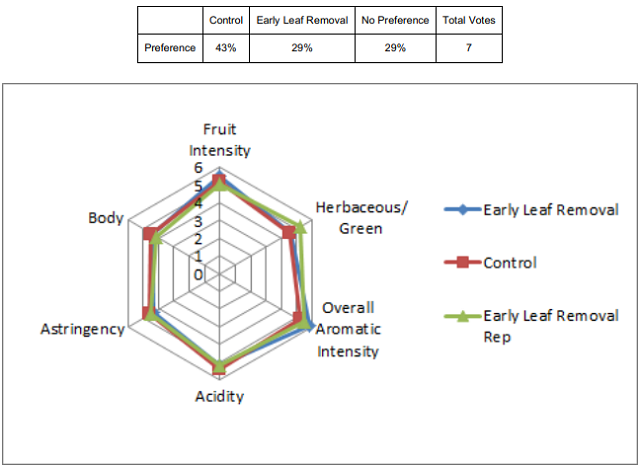
For the triangle test on the April 26 tasting, of 22 people who answered, 10 people chose the correct wine (45%), suggesting the wines were not significantly different. Of those who correctly identified the wines, no major preference could be seen between wines. No strong trends were found for the descriptors used in this study.

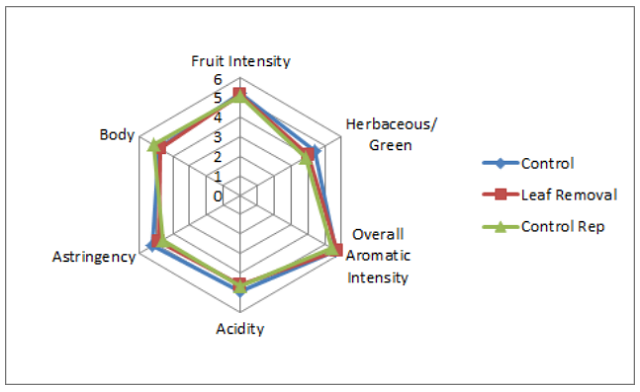
Judges did not find the wines to be significantly different, and there were no strong preference trends for either wine. Early leaf removal may have had a very weak tendency to increase Overall Aromatic Intensity. The lack of differences are likely due in part to the particular vintage (weather events may have equalized the treatments) and in part due to vegetative growth reducing the effectiveness of the bloom leaf removal. More studies need to be performed in this area in order to draw more conclusions.
Methods
This project was done on a 3.05 acre block (28 rows) of Cabernet Sauvignon first planted in 2006 on Penn Silt Loam with very little slope. Every other row had the four most basal leaves pulled at 30% bloom. Both treatments had leaves pulled again at veraison. All other vineyard practices were the same. All of the rows were harvested but kept separate on October 18, 2016. Both lots were chilled overnight prior to destemming into matching T-bins on the following day. No saignée was performed because berry size was thought to be potentially affected by leaf pulling regimes, and as such a saignée would lessen the variation between treatments.
The juice was allowed to cold soak for 3 days before being inoculated with Fermivin A33 at 20g/hL and Go Ferm at 25 on 10/22. YAN was corrected to 255ppm over the course of four days by adding 25g/hL Fermaid K on 10/22 and 63g/hL DAP on 10/26. Tartaric acid was also added on 10/23 at 100g/hL. There was one punch down daily during cold soak and two punch downs daily during fermentation. The wine was pressed directly into barrel on 11/1 for a total of 13 days maceration, and only free run wine was used for this project. Both lots were inoculated with 1g/hL Omega Malolactic Bacteria on 11/3. Both lots had completed malolactic conversion and were stabilized with 8g/hL KMBS on November 22, 2016. The wine was placed into identical new Taransaud Ref 102 M+TH Nevers barrels.
This project was tasted on April 12 and April 26. For the triangle test and preference analysis, anybody who did not answer the form were removed from consideration for both triangle, degree of difference, and preference. Additionally, anybody who answered the triangle test incorrectly were removed from consideration for degree of difference and preference. Additionally, any data points for preference which did not make sense (such as a person ranking a wine and its replicate at most and least preferred, when they correctly guessed the odd wine) were removed.
In order to balance the data set to perform statistical analysis for descriptive analysis on the April 12 tasting, any judge who had not fully completed the descriptive analysis ratings were removed. In order to then make the amount of judges between groups equivalent, one judge from group 2 was transferred to group 3, and another judge from group 2 was eliminated. This resulted in a final data set of 3 groups, each with 5 judges (considered as replications within groups, and groups were considered as assessors). Data was analyzed using Panel Check V1.4.2. Because this is not a truly statistical set-up, any results which are found to be statistically significant (p<0.05) will be denoted as a “strong trend” or a “strong tendency,” as opposed to general trends or tendencies. The statistical significance here will ignore any other significant effects or interactions which may confound the results (such as a statistically significant interaction of Judge x Wine confounding a significant result from Wine alone). The descriptors used in this study were Fruit Intensity, Herbaceous/Green, Overall Aromatic Intensity, Acidity, Astringency, and Body.
The same procedures for data analysis were used on the April 26 tasting. In order to balance the data set for descriptive analysis, one judge was moved from group 1 to group 2, for a total of 3 groups each with 6 judges.
References
Smith, M. and Centinari, M. 2017. Early season grapevine canopy management, Part II: Early leaf removal (ELR). Wine & Grapes U. https://psuwineandgrapes.wordpress.com/2017/06/02/early-season-grapevine-canopy-management-part-ii-early-leaf-removal-elr/
Wolf, T. 2001. Canopy management tips. Viticulture Notes 16(3). Vineyard and Winery Information Series. http://www.sites.ext.vt.edu/newsletter-archive/viticulture/01mayjune/01mayjune.html.
Coombe, B.G. 1962. The effect of removing leaves, flowers and shoot tips on fruit-set in Vitis vinifera L. J. Hortic. Sci. 37:1-15.
Poni, S., Casalini, L., Bernizzoni, F., Civardi, S., and Intrieri, C. 2006. Effects of early defoliation on shoot photosynthesis, yield components, and grape composition. Am J. Enol. Vitic. 57: 397-407.

